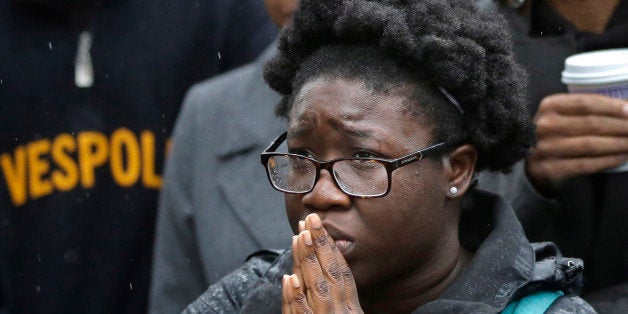
This is my 20 year as an administrator in higher education. I've negotiated hunger strikes, sit-ins, and many other forms of protest and dissent intended to draw needed attention to matters of racial justice.
Yet, long before I was an administrator, the demands of student movements on college campuses were much the same as those we see currently. To be sure, some incremental progress has been achieved over the years. Today, however, we have a unique opportunity to reimagine the academy -- not just to move the margins closer to the center but to redefine the very center.
As higher education institutions respond to the recent demands of their students, it is striking that not a single institution of which I am aware is calling for a paradigm shift for racial justice -- a reimagining of the university. Historically, higher education in general has not been at the forefront of issues of racial justice. Instead, universities have tended to offer three dominant types of responses to student demands for racially just campuses: the implementation of bureaucratic multiculturalism, calls for evidence, and commitments to support academic freedom at any cost.
Bureaucratic Multiculturalism
The first response is predictable. Institutions implement programs and services to address demands. This response typically reminds the community of what is already in place and describes bureaucratic, yet important processes (e.g., faculty governance, board approval, task forces) that will address students' concerns. In this scenario, significant resources often are expended in attempts to create a more equitable community and obviate future disputes.
This response often involves institutions reacting to student protests by creating identity spaces, but too often with insufficient resources and space. Unwittingly, institutions pit marginalized groups against one another by providing each identity group with inadequate resources, which results in competition for already limited resources. Moreover, this outdated multicultural model does not give full consideration to the complexities of the identities that students bring with them to campus.
This response rarely unpacks systemic issues and frequently results in a patchwork that only modestly improves the quality of life for students. Often students settle for the patchwork because of their busy lives, short tenure at the university, and frustration with institutional bureaucracy.
Calls for Evidence
The second response is the hackneyed trope of public discourse -- the calls for "evidence" to support claims made by students. This is not to suggest that such evidence isn't important, that it does not exist, or that it cannot be produced.
Notably, those in power in the academy may privilege quantitative data over the qualitative evidence that can take into account the lived experiences of marginalized groups. Those who fit neatly into institutional structures are in a position to demand such evidence before acknowledging the need to reimagine the existing structures that privilege those in power.
The stakes are high for all parties. Individuals privileged with social capital emphasize that higher education was nobly integrated a half century ago, and they suggest that people of color should be more resilient and show greater respect for the tenets of these venerable institutions.
To people of color, the master narrative reminds us that we are merely guests of these institutions -- guests who are expected to assimilate into archaic systems. Respectability politics reminds us that academic freedom for people of color comes with rules. The opinions and ideas of people of color are valued so long as they do not challenge the master narrative rendering people of color ersatz. Calls for evidence become palisade-like barriers that marginalized groups must negotiate to become fully accepted into the academy.
Their personhood and identity, their very agency, are intertwined with this new racial justice movement. It is here that the policing of black bodies intersects with the exclusionary higher education master narrative regarding people of color and their place in society. It often legitimizes discriminatory acts, even violent acts, on college campuses.
Academic Freedom
The third typical response from higher education calls for protecting academic freedom and open expression. It is as if somehow these hallowed principles are threatened by marginalized groups exercising what access they have to open expression in their call for institutional reforms such as safe spaces, racial sensitivity training, and greater diversity in the curriculum.
The argument behind this institutional response tends to mask or deny the reality of persistent and pervasive social injustice. When students of color object to offensive and hateful language, the institutional response often is: We must safeguard open expression at all cost -- even if it means offending others.
The response of students of color to the frequent abuses of open expression directed at them historically has been to seek safe spaces. These are places in which they can more fully develop and exercise their own access to open expression while they counter the effects of microaggressions, verbal assaults, and racial subjugation. Theirs is not a call for self-segregation, and they are not excluding others but empowering themselves in communities where their disempowerment is pervasive.
Community members should not feel excluded by these safe spaces but, instead, reach out in partnership to co-create other safe spaces and opportunities for civil and respectful dialogue and debate, growth and understanding. Shared safe spaces can and do facilitate discussion of ideas that may be uncomfortable but afford us opportunities to explore points of view and ideas on which we differ and those that we share.
Marginalized students are engaging in open expression at the risk of retaliation. They are leading courageously and giving voice to many who otherwise would have no voice. They are organizing across institutional boundaries and creating a powerful new racial justice movement. Or perhaps, more accurately, they are picking up the mantle of the old movement, giving our institutions of higher education a chance to be -- this time around -- on the right side of history.
Reshaping the Center
Today's racial justice movement is viewed by some as a distraction -- a moment in time that we must move beyond so we can get back to business as usual. Ironically, the mission of U.S. higher education that makes it special -- to develop, teach, and employ knowledge to serve the greater good -- closely aligns with the new racial justice movement.
On a daily basis, faculty drive innovation in a variety of disciplines. At Emory, our success in fighting Ebola has been well-documented. As with other institutions of higher education, the same energy and passion are sorely needed around issues of racial justice. The cultural norms and traditions of our nation's institutions of higher education are impeding the necessary intellectual and financial resources required to apply our knowledge of racial justice in the service of humanity.
We must refocus the business of higher education on creating spaces where all members of our community are afforded opportunities to be liberated through knowledge and encouraged to pass on that knowledge to positively transform their communities and the world. Imagine an academy that prioritized racial justice with the same Shakti as other issues we tackle on a daily basis.
To move towards this goal, we should consider 10 principles:
1. Promote a paradigm shift for institutions to commit to racial justice. We should prioritize racial justice just as we have prioritized other important social issues.
2. Ensure ongoing and sustainable efforts to address issues of racial justice. Our efforts tend to wane during the period between student activists graduating and a new generation of activists emerging. We must: foster institutional memory among students, staff, and faculty; develop leadership skills, provide mentoring; and create advisory structures that have actionable ideas, timelines, metrics, and accountability measures.
3. Reimagine multicultural models to a polycultural framework that recognizes that each of us is a composite of many identities, and that we cannot be defined solely by traditional criteria like race, religion, ethnicity, gender, sexual orientation, disability, or any other single aspect of the complex beings that we are.
4. Appropriately balance the work of change. Students are often working towards change with little administrative support. Systemic change will require administrative support. Identify key administrators who can provide support and guidance to students. Although there is an educational opportunity for students to participate in activism, it often comes at a significant cost to their academics which we must try to mitigate.
5. Build trust with our students by listening carefully and demonstrating compassion and care. Develop transparency in these matters by routinely communicating what is happening and where we are headed.
6. Provide students with the skills to successfully balance the needs of a culturally humble, socially just community and their own personal rights and desires.
7. Encourage coalition-building among marginalized groups so they can discover shared histories of oppression and develop shared agendas to promote racial justice.
8. Promote a collaborative response between academic and student affairs. The integration of academic affairs and student life will help deploy resources more effectively and foster a more holistic approach to addressing racial justice in our communities.
9. Engage all stakeholders in the change process. The board, faculty, alumni, students, and staff must have a voice for systemic change to occur.
10. Encourage debate and dialogue. Open and honest engagement with evidence in its myriad forms is critical to the productive exchange of ideas.
This is a watershed moment for higher education. We have a unique opportunity to reimagine our work on racial justice, learn from our history, and move beyond it by redefining our role as institutions of learning.
This moment affords us a chance to respond with sincere compassion and true justice, to finally transform into reality the vision of our campus communities as caring and diverse centers of learning where all students are afforded equal access to opportunities to grow and learn and contribute to the greater good.
